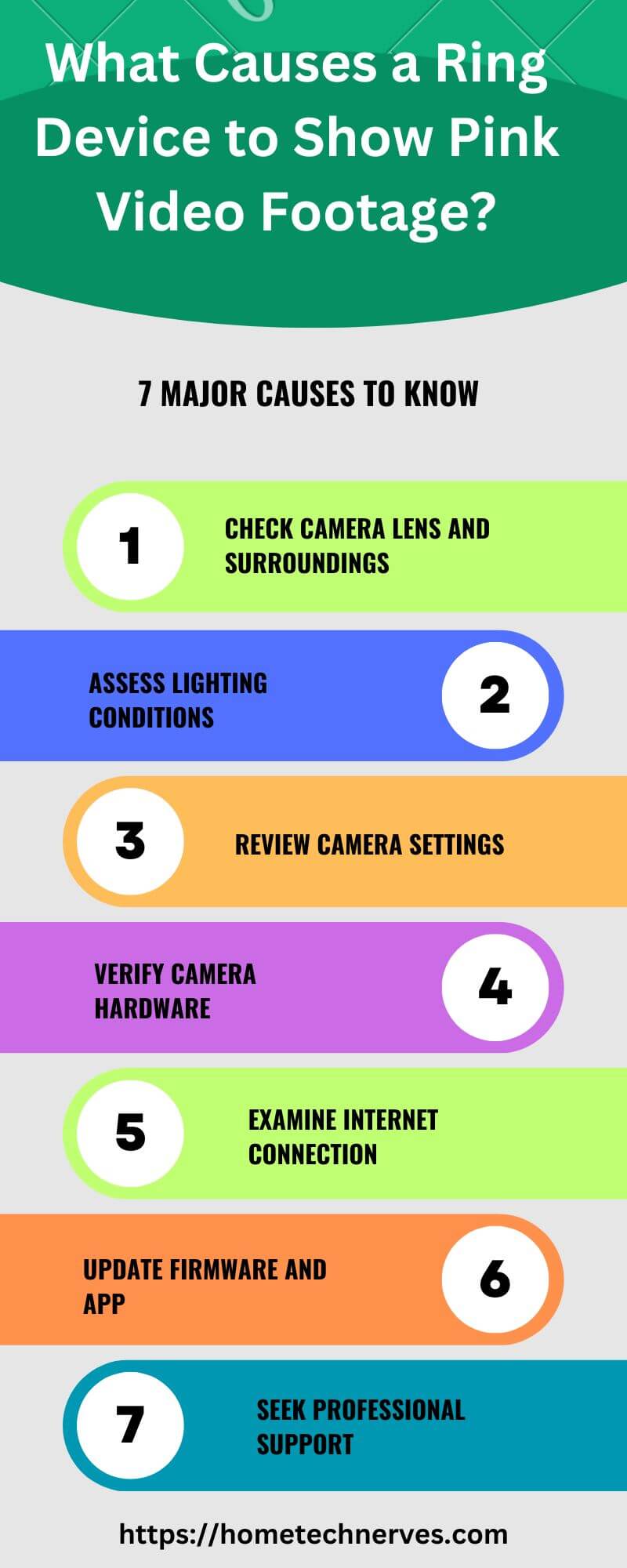Are you perplexed by the unusual pink tint on your Ring camera’s video feed? The last thing you expect when checking your home security footage is a burst of vibrant pink hue.
Fear not! In this article, we will explore the fascinating reasons behind this color anomaly and provide you with valuable insights on how to fix it.
Read more: Home Security Systems
What Is a Ring Device?
A Ring device is a brand of smart home security products designed to enhance home protection and convenience. It typically includes video doorbells, security cameras, and alarm systems that can be accessed and controlled remotely through a smartphone app.
The devices offer features like real-time video monitoring, two-way communication, and motion detection, allowing users to keep an eye on their property and respond to potential threats from anywhere.
Table of Contents
Why Is My Ring Camera Pink Meaning
If your Ring camera appears pink or has a pinkish hue, it is likely experiencing an issue with the camera sensor or its settings. The most common reason for this color distortion is an infrared (IR) filter problem.
Ring cameras use infrared LEDs for night vision, and a malfunctioning IR filter can cause the pink tint when switching between day and night modes.
Additionally, improper white balance settings or lighting conditions can also contribute to the pink appearance.
To resolve this, try resetting the camera, ensuring proper lighting, and adjusting white balance settings in the app. If the problem persists, contact Ring’s customer support for further assistance.
How Does Color Night Vision Work?
Color night vision is an advanced feature in some modern security cameras that allows them to capture and display color images even in low-light or dark conditions.
Unlike traditional night vision, which produces monochromatic images using infrared light, color night vision utilizes specialized technology to provide a more detailed and realistic view of the environment.
- Low-Light Image Sensors: Color night vision cameras are equipped with high-quality image sensors that have a larger pixel size and improved sensitivity to light. These sensors can gather more light information, enabling the camera to capture color images in low-light environments.
- Enhanced Image Processing: Advanced image processing algorithms play a crucial role in color night vision. These algorithms analyze the data captured by the image sensor and enhance the colors, contrasts, and details to create a more vibrant and clear image, even in the absence of ample lighting.
- Supplemental Lighting: In color night vision cameras, supplemental lighting sources, such as visible light LEDs, are used to illuminate the scene. These LEDs emit light that is not visible to the human eye but can be detected by the camera’s image sensor. By combining this supplemental lighting with image processing, the camera can present color images in low-light situations.
- Dual Sensor Technology: Some color night vision cameras employ dual-sensor technology, where one sensor captures visible light for color information, and the other sensor captures infrared light for night vision. These sensors work in tandem, allowing the camera to seamlessly switch between color and infrared night vision based on the ambient lighting conditions.
- Dynamic Range Management: Color night vision cameras often incorporate dynamic range management to handle varying levels of light in a scene. By balancing the exposure of bright and dark areas, these cameras can produce well-lit, colorful images with improved visibility, even in challenging lighting situations.
- Infrared Cut Filters: Color night vision cameras may also feature an infrared cut filter that automatically adjusts based on lighting conditions. During the day, the filter blocks infrared light to capture true color images, and at night, it moves out of the way to allow infrared light for low-light and night vision.
Color night vision technology continues to advance, providing homeowners and businesses with better surveillance capabilities during the night and low-light conditions, thereby increasing the overall security and awareness of their properties.
What Causes a Ring Device to Show Green/Purple/Pink Video Footage?
Ring devices occasionally display unusual video footage with green, purple, or pink tints, which can be concerning for users. Understanding the causes behind these color distortions can help troubleshoot and resolve the issue effectively.
Infrared Interference:
The presence of strong infrared light sources, such as direct sunlight or artificial lighting with IR radiation, can cause color distortion in Ring camera footage. The camera’s image sensor may react to the infrared light, leading to green, purple, or pink hues in the video.
Faulty IR Cut Filter:
Ring cameras are equipped with an infrared cut filter that switches between day and night modes to ensure accurate color representation. A malfunctioning or misaligned IR cut filter can result in improper color filtering, causing unusual tints in the video footage.
Low Light Conditions:
In low-light environments, Ring cameras rely on infrared LEDs for night vision. However, if the camera struggles to detect adequate light, it may produce distorted colors, such as green or pink, as it tries to compensate for the lack of illumination.
White Balance Settings:
Incorrect white balance settings in the camera’s configuration can affect color accuracy. If the white balance is not properly calibrated, it can lead to a shift in color temperature, resulting in green, purple, or pink color casts in the video.
Video Compression Artifacts:
During video transmission and storage, compression algorithms are used to reduce file size. Sometimes, these compression techniques can introduce artifacts that manifest as color abnormalities, leading to green, purple, or pink hues in the recorded footage.
Software or Firmware Issues:
Software bugs or firmware glitches can also be responsible for color distortion in Ring video footage. Updates or changes in the camera’s software can inadvertently impact color processing, causing unusual color shifts in the video.
Understanding the potential causes behind green, purple, or pink video footage in Ring devices can guide users in troubleshooting and resolving the issues effectively.
If problems persist despite attempting basic troubleshooting steps, it’s recommended to reach out to Ring’s customer support for further assistance and potential device evaluation or replacement.

6 Best Ways to Fix a Stuck IR Filter In Your Ring Device
A stuck IR filter can cause color distortion and affect night vision performance in your Ring device. Here are six effective methods to fix the issue and restore optimal functionality.
- Perform a Power Cycle: Turn off the Ring device, unplug it, wait for a few minutes, and then plug it back in to reset the IR filter mechanism.
- Check for Obstructions: Inspect the camera lens for any dirt, debris, or physical obstructions that might be hindering the movement of the IR filter.
- Update Firmware and Software: Ensure your Ring device has the latest firmware and software updates installed, as manufacturers often release fixes for mechanical issues.
- Adjust Night Vision Settings: Modify the night vision settings in the Ring app to see if manually adjusting the IR filter resolves the problem.
- Apply Gentle Taps: Sometimes, gently tapping the camera’s housing can dislodge a stuck IR filter, but exercise caution to avoid causing further damage.
- Contact Customer Support: If all else fails, get in touch with Ring’s customer support for professional assistance or potential device replacement.
7 Steps to Fix Ring Floodlight Camera Pink Screen
Fixing a Ring Floodlight Camera‘s pink screen issue may require troubleshooting both hardware and software aspects. Here are seven steps to help resolve the problem:
- Check Lighting Conditions: Ensure that the area around the camera has adequate lighting. Low-light environments can lead to color distortions in the footage. Adjust external lighting or consider using additional lighting sources if needed.
- Power Cycle the Camera: Turn off the camera by disconnecting its power source. Wait for about 30 seconds, then plug it back in. This can help reset the camera’s settings and potentially resolve temporary software glitches causing the pink screen.
- Check Night Vision Settings: Verify the night vision settings in the Ring app. Adjust the settings to see if it affects the color representation. Try switching between different night vision modes to find the one that produces the most accurate colors.
- Update Firmware and App: Ensure both the camera’s firmware and the Ring app are up-to-date. Manufacturers often release updates to address known issues and improve overall performance.
- Inspect IR Cut Filter: The pink screen issue may be related to a malfunctioning or stuck IR cut filter. Carefully check the camera’s lens area for any debris, dirt, or obstructions that could affect the filter’s movement. If possible, gently clean the lens using a soft, lint-free cloth.
- Perform a Factory Reset: As a last resort, consider performing a factory reset on the camera. This will restore the camera to its default settings, which may resolve any software-related issues causing the pink screen problem.
- Contact Customer Support: If none of the above steps fix the issue, reach out to Ring’s customer support for further assistance. They can provide additional troubleshooting steps or guide you through the process of getting a replacement if the camera is still under warranty.
Always exercise caution when troubleshooting your Ring Floodlight Camera, and follow the manufacturer’s instructions and safety guidelines. If the camera is still covered by warranty, avoid attempting any repairs that might void the warranty.
Wrap Up
A pink Ring camera may seem puzzling at first, but now you are equipped with the knowledge to tackle this unexpected issue.
Whether it’s an infrared filter glitch, improper lighting, or a simple firmware update, troubleshooting the pink tint can restore your camera’s accurate color representation.
With a bit of technical know-how and our helpful tips, your Ring camera will be back to capturing crisp, clear video footage, ensuring your home security remains top-notch.
Frequently Asked Questions
Why is my Ring camera showing a pink screen?
A pink screen on your Ring camera may indicate a hardware issue or a problem with the camera’s lens. Try restarting the camera and checking for any obstructions or damage. If the issue persists, contact Ring support for further assistance.
What causes a pink tint on my Ring camera’s video feed?
A pink tint in the video feed of your Ring camera can result from improper camera settings or a malfunctioning lens. Ensure your camera lens is clean and try resetting the camera. If the issue continues, seek help from Ring customer support.
How can I fix a pink hue on my Ring camera?
To fix a pink hue on your Ring camera, start by cleaning the lens to remove any dirt or smudges. Restart the camera and check the settings. If the problem persists, there may be a hardware issue requiring professional repair or replacement.
Is a pink camera image a sign of a malfunction?
Yes, a pink image on your Ring camera often signals a malfunction, either with the camera’s hardware or its lens. Perform basic troubleshooting steps like cleaning and restarting. For persistent issues, contacting Ring support or considering a replacement may be necessary.
References:
Ring. Pink image. https://community.ring.com/t/pink-image/8486


